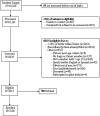Differences in prevalence of urinary incontinence by race/ethnicity
- PMID: 16406923
- PMCID: PMC1557354
- DOI: 10.1016/S0022-5347(05)00039-X
Differences in prevalence of urinary incontinence by race/ethnicity
Abstract
Purpose: We compared the prevalence of urinary incontinence by type among white, black, Hispanic and Asian-American women.
Materials and methods: The RRISK is a population based cohort study of 2,109 randomly selected middle-aged and older women. Incontinence and other variables were assessed by self-report questionnaires and in person interviews. Labor and delivery and surgical data were abstracted from medical records archived since 1946. Logistic regression was used to estimate the OR with 95% CIs for incontinence while adjusting for covariates.
Results: The age adjusted prevalence of weekly incontinence was highest among Hispanic women, followed by white, black and Asian-American women (36%, 30%, 25% and 19%, respectively, p <0.001). Type of incontinence also differed among groups, with weekly stress incontinence prevalence being 18%, 15%, 8% and 8% (p <0.001), and weekly urge incontinence prevalence being 10%, 9%, 14% and 7% (p <0.001). After adjustment for age, parity, hysterectomy, estrogen use, body mass, menopausal status and diabetes, the risk of stress incontinence remained significantly lower in black (adjusted OR 0.36, 95% CI 0.23-0.57) and Asian-American (adjusted OR 0.54, 95% CI 0.34-0.86) women compared to white women. In contrast, the risk of urge incontinence was similar in black (adjusted OR 1.19, 95% CI 0.79-1.81) and Asian-American (adjusted OR 0.86, 95% CI 0.52-1.43) women compared to white women.
Conclusions: Significant differences in the adjusted risk of stress incontinence among Hispanic, white, black and Asian-American women suggest the presence of additional, as yet unrecognized, risk or protective factors for stress incontinence.
Figures



References
-
- Nygaard I, Turvey C, Burns TL, Crischilles E, Wallace R. Urinary incontinence and depression in middle-aged United States women. Obstet Gynecol. 2003;101:149. - PubMed
-
- Fultz NH, Herzog AR, Raghunathan TE, Wallace RB, Diokno AC. Prevalence and severity of urinary incontinence in older African American and Caucasian women. J Gerontol A Biol Sci Med Sci. 1999;54:M299. - PubMed
-
- Burgio KL, Matthews KA, Engel BT. Prevalence, incidence and correlates of urinary incontinence in healthy, middle-aged women. J Urol. 1991;146:1255. - PubMed
-
- Duong TH, Korn AP. A comparison of urinary incontinence among African American, Asian-American, Hispanic and white women. Am J Obstet Gynecol. 2001;184:1083. - PubMed
-
- Mattox TF, Bhatia NN. The prevalence of urinary incontinence or prolapse among white and Hispanic women. Am J Obstet Gynecol. 1996;174:646. - PubMed
Publication types
MeSH terms
Grants and funding
LinkOut - more resources
Full Text Sources
Other Literature Sources
Medical

